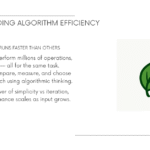When you’re learning data structures, understanding how arrays perform is crucial for writing efficient code. Today, we’ll dive deep into how arrays work under the hood, their Big O complexity, and when to use them versus other data structures like objects.
What Makes Arrays Special?
Arrays are one of the most fundamental data structures in programming. Their superpower lies in one key feature: order. Unlike objects where properties float around without any inherent sequence, arrays maintain a strict order of elements.
// Array with ordered elements
const colors = ['red', 'green', 'blue', 'yellow'];
console.log(colors[0]); // 'red' - always the first element
console.log(colors[2]); // 'blue' - always the third element
// Object without inherent order
const colorObj = {
primary: 'red',
secondary: 'green',
tertiary: 'blue'
};
// Properties don't have guaranteed order
Each element in an array has an index – a numeric position that never changes unless you specifically modify the array structure.
When Should You Use Arrays?
The golden rule is simple: use arrays when you need order. If you’re just storing random data together without caring about sequence, arrays might not be your best choice for optimal performance.
Here are scenarios where arrays shine:
- Storing a list of users in registration order
- Maintaining a shopping cart where item order matters
- Creating a playlist where song sequence is important
- Building a todo list with priority ordering
Array Access: Lightning Fast Performance
One of the biggest misconceptions developers have is thinking that accessing elements in large arrays is slow. Let’s clear this up!
The Truth About Array Access
const hugeArray = new Array(50000).fill(0).map((_, i) => `item-${i}`);
// All of these operations take the SAME amount of time!
console.log(hugeArray[0]); // First element
console.log(hugeArray[25000]); // Middle element
console.log(hugeArray[49999]); // Last element
Array access is O(1) – constant time! This means whether you’re accessing the first element or the 50,000th element, it takes exactly the same amount of time.
Why Is This Possible?
Think of arrays like a hotel hallway. If you know the room number (index), you can walk directly to that room without checking every door along the way. JavaScript doesn’t count through every element – it jumps directly to the memory location.
const studentGrades = [85, 92, 78, 94, 87];
// JavaScript doesn't do this:
// "Let me check index 0... nope, not what I want"
// "Let me check index 1... nope, not what I want"
// "Let me check index 2... nope, not what I want"
// "Ah! Index 3 has what I need!"
// JavaScript actually does this:
console.log(studentGrades[3]); // Direct jump to index 3 → 94
The Performance Cost of Order: Insertion and Removal
While arrays excel at access, their ordered nature creates performance challenges when inserting or removing elements. Let’s explore why.
Adding to the End: The Sweet Spot
Adding elements to the end of an array is blazingly fast – O(1) constant time.
const fruits = ['apple', 'banana', 'orange'];
// Adding to the end - super fast!
fruits.push('grape');
console.log(fruits); // ['apple', 'banana', 'orange', 'grape']
// Why is this fast?
// - No existing elements need to move
// - Just assign the new value to the next available index
// - Update the array length
Adding to the Beginning: The Performance Killer
Now here’s where things get expensive. Adding to the beginning forces every existing element to shift positions.
const animals = ['cat', 'dog', 'bird'];
console.log('Before:', animals);
// Indices: 0 1 2
// Adding 'fish' to the beginning
animals.unshift('fish');
console.log('After:', animals);
// ['fish', 'cat', 'dog', 'bird']
// 0 1 2 3
// What happened behind the scenes:
// 1. 'bird' moved from index 2 to index 3
// 2. 'dog' moved from index 1 to index 2
// 3. 'cat' moved from index 0 to index 1
// 4. 'fish' assigned to index 0
This is O(n) linear time because the operation time grows proportionally with the array size.
Visual Example: The Domino Effect
Imagine you have 10,000 books on a shelf, numbered 1-10,000. If you want to add a new book as #1, you have to:
- Move book #10,000 to position #10,001
- Move book #9,999 to position #10,000
- Move book #9,998 to position #9,999
- … and so on for all 10,000 books!
// Performance demonstration
const smallArray = [1, 2, 3];
const largeArray = new Array(10000).fill(0).map((_, i) => i);
console.time('Small array unshift');
smallArray.unshift(0);
console.timeEnd('Small array unshift');
console.time('Large array unshift');
largeArray.unshift(0);
console.timeEnd('Large array unshift');
// The large array will take significantly longer!
Removing Elements: Same Rules Apply
The same performance principles apply to removal:
const numbers = [10, 20, 30, 40, 50];
// Removing from the end - fast O(1)
numbers.pop(); // [10, 20, 30, 40]
// Removing from the beginning - slow O(n)
numbers.shift(); // [20, 30, 40]
// Every remaining element must shift down one position
Searching Arrays: The Linear Challenge
When you need to find a specific element in an unsorted array, you’re looking at O(n) linear time complexity.
const employees = [
'Alice Johnson',
'Bob Smith',
'Charlie Brown',
'Diana Prince',
'Eve Wilson'
];
// Finding 'Diana Prince' - worst case scenario
function findEmployee(name) {
for (let i = 0; i < employees.length; i++) {
console.log(`Checking: ${employees[i]}`);
if (employees[i] === name) {
return i;
}
}
return -1;
}
findEmployee('Diana Prince');
// Output:
// Checking: Alice Johnson
// Checking: Bob Smith
// Checking: Charlie Brown
// Checking: Diana Prince
// Found at index 3
In the worst case, you might need to check every single element. As your array grows from 100 to 10,000 to 1,000,000 elements, search time grows proportionally.
Built-in Array Methods and Their Performance
Let’s examine how common array methods perform:
Lightning Fast Methods – O(1)
const items = ['a', 'b', 'c', 'd'];
// These are constant time - array size doesn't matter
items.push('e'); // Add to end
items.pop(); // Remove from end
items[2]; // Access by index
items.length; // Get length
Linear Time Methods – O(n)
Most array methods need to process every element, making them O(n):
const scores = [85, 92, 78, 96, 88];
// These methods loop through every element
scores.map(score => score * 1.1); // Apply bonus to all scores
scores.filter(score => score >= 90); // Find high scores
scores.reduce((sum, score) => sum + score, 0); // Calculate total
scores.forEach(score => console.log(score)); // Print all scores
// Array manipulation methods
scores.slice(1, 3); // Copy portion of array
scores.concat([100, 95]); // Merge arrays
The Heavy Hitters – O(n log n)
const randomNumbers = [64, 25, 12, 22, 11, 90];
// Sorting is more complex than linear time
randomNumbers.sort((a, b) => a - b);
// This is O(n log n) - we'll explore why in sorting algorithms!
Performance Comparison Example
const testArray = new Array(100000).fill(0).map(() => Math.random() * 1000);
console.time('Access (O(1))');
testArray[50000]; // Instant
console.timeEnd('Access (O(1))');
console.time('Push (O(1))');
testArray.push(999);
console.timeEnd('Push (O(1))');
console.time('Unshift (O(n))');
testArray.unshift(0);
console.timeEnd('Unshift (O(n))');
console.time('Map (O(n))');
testArray.map(x => x * 2);
console.timeEnd('Map (O(n))');
console.time('Sort (O(n log n))');
testArray.sort((a, b) => a - b);
console.timeEnd('Sort (O(n log n))');
Arrays vs Objects: Making the Right Choice
Understanding when to use arrays versus objects is crucial for performance:
Use Arrays When:
- Order matters
- You need indexed access
- You’re building lists or sequences
- You need array methods like
map,filter,reduce
// Perfect for arrays
const shoppingCart = ['laptop', 'mouse', 'keyboard']; // Order matters for checkout
const timeline = ['login', 'browse', 'add_to_cart', 'checkout']; // Sequence is important
Use Objects When:
- You need key-value relationships
- Order doesn’t matter
- You want fast property access
- You’re modeling real-world entities
// Perfect for objects
const userProfile = {
username: 'john_doe',
email: 'john@example.com',
age: 28,
isActive: true
};
// Fast property access - O(1)
console.log(userProfile.username); // Instant lookup
Performance Best Practices
1. Prefer End Operations
// Good - O(1) operations
const queue = [];
queue.push(item); // Add to end
queue.pop(); // Remove from end
// Avoid if possible - O(n) operations
queue.unshift(item); // Add to beginning
queue.shift(); // Remove from beginning
2. Use the Right Tool for the Job
// If you need beginning insertion frequently, consider other structures
class Queue {
constructor() {
this.items = {};
this.head = 0;
this.tail = 0;
}
enqueue(item) {
this.items[this.tail] = item;
this.tail++;
}
dequeue() {
const item = this.items[this.head];
delete this.items[this.head];
this.head++;
return item;
}
}
3. Batch Operations When Possible
// Instead of multiple single insertions
const data = [];
for (let i = 0; i < 1000; i++) {
data.unshift(i); // O(n) each time = O(n²) total!
}
// Better approach
const data = [];
for (let i = 0; i < 1000; i++) {
data.push(i); // O(1) each time = O(n) total
}
data.reverse(); // O(n) once = O(n) total
Common Pitfalls to Avoid
1. The Nested Loop Trap
// This is O(n²) - avoid when possible!
const duplicates = [];
for (let i = 0; i < arr1.length; i++) {
for (let j = 0; j < arr2.length; j++) {
if (arr1[i] === arr2[j]) {
duplicates.push(arr1[i]);
}
}
}
// Better approach using Set - O(n + m)
const set2 = new Set(arr2);
const duplicates = arr1.filter(item => set2.has(item));
2. Unnecessary Array Copying
// Expensive - creates new array each time
let result = [];
for (let i = 0; i < 1000; i++) {
result = [...result, i]; // O(n) each time!
}
// Better - modify in place
const result = [];
for (let i = 0; i < 1000; i++) {
result.push(i); // O(1) each time
}
What’s Next?
Arrays are just one piece of the data structure puzzle. While they excel at providing order and fast access, they’re not always the best choice for every scenario. Coming up in future posts, we’ll explore:
- Linked Lists: Ordered structures where beginning insertion is O(1)
- Stacks and Queues: Specialized array-like structures
- Hash Tables: The secret behind object performance
- Sorting Algorithms: Why
Array.sort()is O(n log n)
Key Takeaways
- Arrays shine when order matters – but this comes with performance trade-offs
- Access is always O(1) – array size doesn’t affect lookup speed
- End operations are fast (O(1)) –
push()andpop()are your friends - Beginning operations are slow (O(n)) – avoid
unshift()andshift()when possible - Most array methods are O(n) – they need to process every element
- Choose the right data structure – arrays aren’t always the answer
Understanding these performance characteristics will help you write more efficient code and make better architectural decisions. Remember, premature optimization is the root of all evil, but understanding the performance implications of your choices is always valuable!
Ready to dive deeper into data structures? Check out our upcoming posts on linked lists, stacks, and queues to see how they compare to arrays in different scenarios.
Thanks!
– Grass Coder





